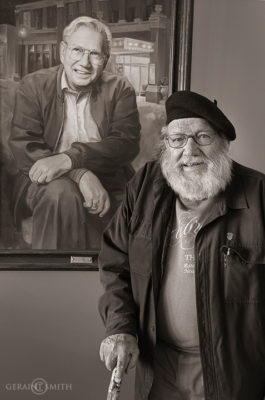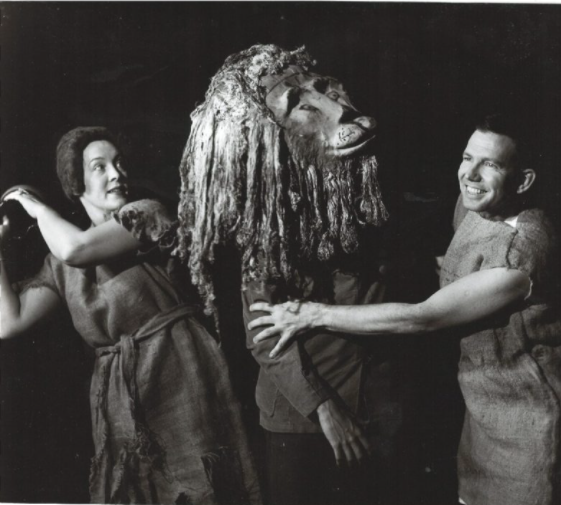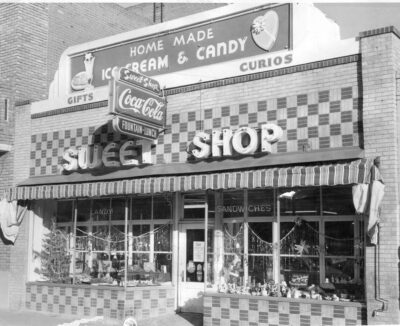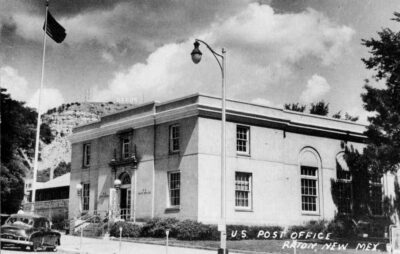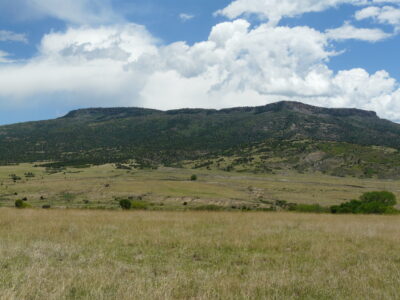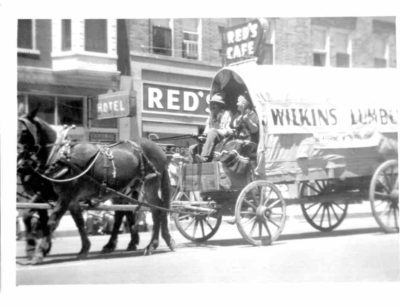In Fond Memory of Bill Fegan
Actor, Director, Producer, Booking Agent, Entrepreneur
who established a permanent base for professional theater in Raton
and brought cultural enrichment to many
1927-2021
Theater Group Found Home at Shuler and National Popularity
by Pat Veltri
Originally published in The Raton Range, May 27, 2008,
The Trinidad Times Independent, June 6, 2008
In the summer of 1963, Bill Fegan and his Kaleidoscope Players arrived at the back door of the Shuler Theater to unload stage scenery. They found Lois Donati, Dr. John Smoker, and several others down on their hands and knees.
“Not praying,” jokes Fegan, “but cleaning the leather seats with buckets of warm, soapy water and rags because the seats were covered with coal dust. In those days the theater, the whole building, was heated by coal and there was coal dust everywhere.”
The theater was scrubbed squeaky clean by a brigade of the town’s leading citizens in readiness for the Kaleidoscope Players’ first performance on its stage.
The Kaleidoscope Players, most of whom held Master’s Degrees in speech, drama, or oral interpretation, was a professional theater troupe founded by Fegan when he was a graduate student at the University of Alabama in Tuscaloosa. “Three of us formed a little group to present scenes from shows and toured around northeastern Alabama,” he says.
After earning his Master’s Degree in speech and hearing therapy in 1960, Fegan moved across town from the University of Alabama to take a teaching position at Stillman College, a private Presbyterian, and historically Black, liberal arts college. Since Stillman did not offer a summer school program and Fegan still had a connection with Alkahest Celebrity Bureau, a booking company that he had previously worked for, he decided to expand the itinerary of the Kaleidoscope Players.
“I had been in the booking business in the 1950s for six years with a company and I got that company to put us on tour. So we toured in the summertime,” he says. In 1962 we came out this way and played at the University of Colorado, the University of New Mexico, Highlands University. I remember we had four or five dates in New Mexico.”
Fegan explains how he chose the name Kaleidoscope for his theater troupe: “At that time it was not a known word, people didn’t use it. The kaleidoscope meant a varying change, like the little instrument that you hold up to your eye. When you turn it, it’s something else. So we liked to think of ourselves as diverse, doing different kinds of things, and so I invented the idea.” The group was sometimes billed as being “dedicated to the theatrically unusual”.
While Fegan and the Kaleidoscope Players were touring throughout the United States in the early 1960s, a different scenario was taking place in Raton, New Mexico. The town’s Shuler Theater, once a thriving opera house, was in a sad state of disrepair and the city fathers had decided to lock its doors.
Miss Evelyn Shuler, retired public librarian, was in a quandary about how to revive the city auditorium that her doctor father had a hand in getting built in 1915. Although the theater had thrived in the 1920s and 1930s, bringing in thousands of movies and live shows, the number of shows began to dwindle by the 1940s according to Ken Sandelin in his monograph The Shuler Auditorium: A Theatrical History.
By the 1950s, wrote Sandelin, “live entertainment was rare and even the movies failed to draw as they had in the past.” The movie house lease ended in the 1950s and was not renewed and the theater began to “look a little run down.” Attempts to encourage the preservation and use of the theater by Miss Shuler were in vain until she read a notice in the newspaper about a Kaleidoscope Players performance at Highlands University.
Fegan recalls, “ She contacted the dean down there that was in charge of it and said if ever those Kla-die-a-scope Players, she couldn’t ever say Kaleidoscope, come through here again we might like to have them in our Shuler Theater, and my agent, being a good agent, the following summer in 1963 booked us with the Federation of Women’s Clubs in Raton, New Mexico, for one performance of Androcles and the Lion in the Shuler and that’s how we got here.”
George Bernard Shaw’s comedy classic play was presented on stage at the Shuler
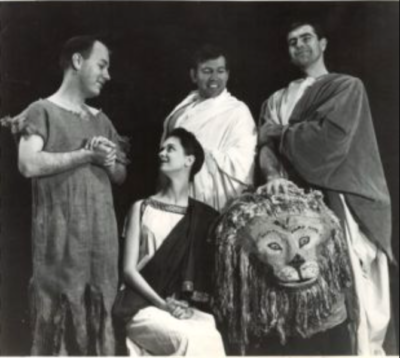
July 30, 1963, under the sponsorship of Raton’s city federation of ten women’s clubs. The actors included Beth Bittick Oaks, Jerry Murray, Greg Congleton, Bill Fegan, Vernon Oaks, and Marion Killinger. Admission was $2.50 per person and the profits, about $70.00, were given to the Shuler Piano Fund to help pay for the theater’s new Steinway Grand Piano.
Following the play, a “Meet the Artist” reception was held at the Raton Museum and Art Center. (At that time the museum was housed in the J.J. Shuler home, now the home of Rick and Linda Trice).
It was at that reception that history was made.
While Fegan was mingling among the guests, John Smoker, Leon Rubin, John Lackey, Charles DiLisio, and a few others got him off in a corner and said, as Fegan remembers, “’What would it take to get the Kaleidoscope Players to come out here and do more shows in the summer? We have a race track and we have nothing to do at night but go to bars and drink, and it would be great because we have this theater.’
“And I said, ‘Money,’ and they said, ‘How much?’ and I said, ‘I haven’t any idea.’”
Before the reception was over Fegan had agreed to meet with the businessmen the following morning. He stayed up half the night “working up a budget” for a four-show schedule.
“At 10:00 the following morning, seventeen businessmen from town came to the upstairs room of the International Bank,” Fegan says. “I remember Lina Cash was there and Dr. Smoker and Leon Rubin and John Lackey and others. I presented my budget and they said, ‘We can do that!’”
In order to get ready for the 1964 season, Fegan sent seventeen-year-old Greg Congleton, by bus, to build scenery.
“The theater was pretty much a mess,” Fegan says. “It was broken down; it had nothing. Burlap curtains were the backdrops and there were no spotlights. We carried some spotlights with us and I remember that we put them in the boxes on the sides so that we could light the stage because all we had was a row of red, white, and blue bulbs, and red, white and blue are not the primary colors of light; red, blue and green are the primary colors of light.”
Fegan recalls some of the original members of the Kaleidoscope Company: “Will Sandy was our leading actor, Sam Buck played character roles, Greg Congleton was in the first group when we did Androcles and the Lion; he played the Lion. Eliza Kent, Lee Billington, and Beth Bittick Oaks were the first women in the company. Ben Zeller came in 1966 and then later Connie Simmons came and she was here for a number of years. Marty McGuire moved here in 1968 and he was in shows as time would allow. He was head of Social Services.”
After Raton and the Shuler became the permanent base for the Kaleidoscope Players, the theatrical group grew rapidly with the support of local businessmen. The group offered three types of touring companies: the regular stock shows, educational assembly programs for elementary and high school students, and dinner theater.
“We toured all over the United States, both summer and winter for a number of years, into the 1970s and did summer theater here at the Shuler,” Fegan says. “Also, we had a large number of one and two-person shows that we put together here in the Shuler that toured to schools and did school assembly programs.”
Every school assembly program was presented locally before the actors went on tour, and at times included some local talent. “There’s one person here in town who toured – Frank Lucero toured with a partner and did Mexican folk dances. Frank’s very good,” Fegan says. “At one time we would have as many as eight shows touring all over the country, just the school assembly shows.”
The Kaleidoscope Players conducted dinner theater tours, playing to audiences in banquet rooms of motels or restaurants in Raton and nearby towns. Raton restaurants featuring dinner theater by the Kaleidoscope Players included Pappas’ Sweet Shop and Phil’s Restaurant (site of the Sonic Drive-in).
A theater guild composed of local citizens formed to assist the Kaleidoscope Players mostly with promotion and publicity, but with anything else that was needed, covering an entire range from ticket sales to ushering.
The Kaleidoscope Players also conducted the New Mexico School for the Performing Arts, an apprenticeship program for outstanding college seniors or graduate students. Many of the apprentices continued to work professionally with one of the Kaleidoscope touring companies.
In 1967 Fegan and the Kaleidoscope Players won the Larry Tajiri Award for outstanding contributions to the theater in the eight-state Rocky Mountain region.
In 1969, the New Mexico State Legislature designated the Kaleidoscope Players as the official State Theater Troupe of New Mexico.
The Players, in turn, presented a yearly Kaleidoscope Award to a Raton citizen who supported the group in an outstanding way. Some of the recipients of the Kaleidoscope Award included Dr. John Smoker, Leon Rubin, Marty McGuire, and Lina Cash.
Still, another enterprise that the Players were involved in was the historic Palace Bar. The group partnered with some people in town and bought the Palace and opened it in 1971. Fegan remembers the Palace “was the entertainment center of town. We did some shows in there, excerpts from musicals from time to time, but we brought in music; we had music every night, six nights a week. Bill and Bonnie Hearne, Dick Kroeckel, the ragtime pianist who brought his own piano, was here many times.”
The Kaleidoscope Players thrived for more than a decade but eventually folded because Fegan had to move out of town. “At the same time that I was running Kaleidoscope,” he says, “I was in the booking business and I would go on the road a lot. The agent who had booked us originally wanted to retire and he was turning the business over to me, and to learn the business I had to move to Panama City, Florida. I left here in 1974 and it (Kaleidoscope) continued for a year or two under some other managers, some of the people who had worked for me, and then it folded.”
Bill Fegan and his Kaleidoscope Players, operating out the Shuler Theater in Raton, brought professional theater, at affordable prices, to communities throughout the United States and Canada.
Fegan reflects on the experience: “Well, it was wonderful. We got to see the world or at least the United States. The professional company played in forty-four states, the student companies played in every state, they went to the schools. I know we played Hawaii and Alaska in the same month, we went from one to the other. The Canadian agency Overture Concerts out of Vancouver booked us all across Canada and Alaska and Hawaii, so it was wonderful.”
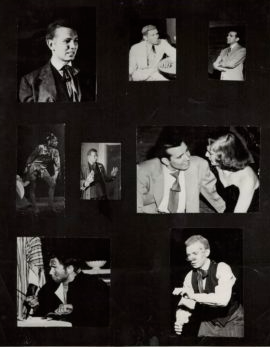
Bill Fegan in differing roles during his Kaleidoscope Players acting days. Upper left corner reading clockwise: as Stage Manager in “Our Town”; as Judge Gaffney in “Harvey”; as Mike Connor in “Philadelphia Story”; Mike and Tracy in “Philadelphia Story”; as Mr. Morgan in “Our Town”; as Robert, the cockney sewer-cleaner in “Servant in the House”; as Touchstone in “As You Like It”; and as WM. Gallagher in “Light Up The Sky”.
